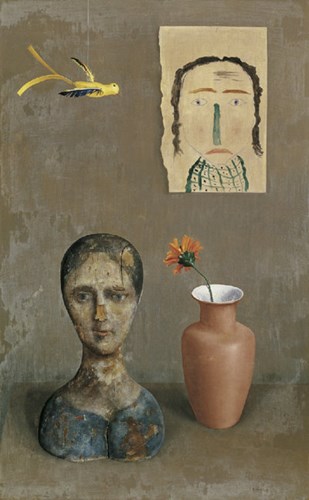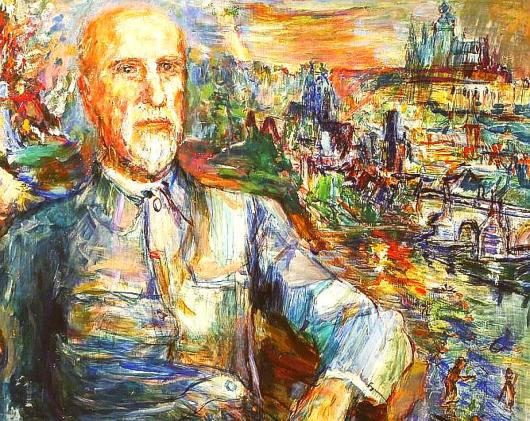Interview by Nicolas Rapold
原文刊载于《Film Comment》2018年2月21日网页版(https://www.filmcomment.com/blog/interview-ildiko-enyedi/)
这部电影的灵感从何而来?
这都源自一些非常基本的感受。记得那是在三月初,早春,天气还很凉,但从空气中你仍能嗅到春日的气息——一种万物初始皆有可能的清新感受。我在街上游荡,看见路人一张张面无表情的脸,但你知道他们心里感受到的和你没什么两样;而他们看到的也是这一张张毫无表情的脸。我想,把这个拍成一部电影倒是个不错的主意。在这世上,有多少事潜藏在表象之后,又有多少感觉我们无法同他人分享。
写作的过程进展得很快,也就几个星期时间——这可能是我最轻松的一段剧作经历。也是在那同一天,我脑海里就浮现出了这两个角色,而且老实说,我也不知道“共享梦境”这个构思究竟是从何而来。我只是想把这两个人放在一个他们无法逃避的情境中,一个他们必须做些什么来改变自己命运的情境。在这样的设置下,我只是把他们所做的事情记录下来而已。
这两个人彼此的梦被互相分享,真是个美妙的创意。这与人们对爱情的思考很像,我们总在想是否对方也有同样的感受,或者在这里,同样的梦境。
有时候你会质疑写出来的故事,会犹豫自己的选择是否正确,会想还有没有更好的方案。这么做都是为了进一步了解自己构思的初衷。这一次我几乎没有怎么更改最初的剧本——这其实挺不寻常的,我所做的就是毫无顾忌地把我想到的写出来。现在我觉得,这个故事似乎讲的是多年以前我读荣格时候的某种感受。弗洛伊德更加关注个人和个人的过去,而荣格则侧重人们潜意识的心理活动。不管乐意与否,我们实际上都将之与他人分享。当我们处在睡梦中,对自己失去绝对控制的时候,你会无比接近自己的,怎么说,心灵吧。因此,梦境有时确实是非常私人的体验,但与此同时,也正是在这些瞬间,你会毫无保留地把自己袒露给他人,这和你在白天里与别人的交往是完全不同的。而这,也正是这部影片所要关注的主题。
这对Maria来说似乎尤其重要,因为平日里的她有交流障碍,你会感觉到她总是不停地去揣摩和分析周围的环境——这一定非常耗费精神。但也正是通过这种方式,她与别人开始建立起联系。
是的,正是这样。
Maria这个角色是从何而来呢?
说实话,我并没有花过多时间精力去“捏造”这两个人物形象。他们在一开始就完整地“出现”在我面前,非常饱满,让我感觉到我似乎已经认识他们很久了。当然,Maria的很多特质也是我自己的一部分,她与周围世界建立起联系的方式某种程度上也是我与外界一点一点熟悉起来的方式。比如说,在我生下孩子之后,我开始学游泳,学骑自行车,只是为了能和孩子们更长时间地在一起。通过这样,我感到自己过上了一种更广阔的生活,和小时候相比,我开始更多与外界接触,你知道孩提时代的我只会呆在家里读书。
好像我有时候也像那个样子……
对,世界上总会有这样的人。说到Endre,我对他也有一样的感触,在他身上看到的其实也是很多非常成功出色男人所曾经历的:当他们衰老的时候,或是体质变弱的时候,他们周围的人开始排挤他,倒不一定是还击。Endre的形象在我脑海里一直很清晰,有一次在西班牙,我在斗牛场看见一头公牛,浑身布满了尘土,脖子上被刀尖刺出了鲜血,双眼已经模糊,但它依然保持着对周围的警惕,并想要尝试再次直起身躯,即使死亡也不能失去尊严。这就是Endre给我们传递的,他曾说:“好吧,我真是个傻瓜,但我只想继续活着,即便存在各种风险。”如果说Maria的风险来自于未知,那么对于Endre来说,风险来自他太了解这种危险的爱情,它的结局会是怎样,它会给双方带来多少伤害,而它又如何会让我们的人生变得一文不值。
这同时让我想到这部影片与“身体”密不可分,两个人工作的地方,也有很多动物的躯体。而且这部影片的名字,《肉与灵》,似乎也在提示我们,其实每个人都是血肉鲜活的,Maria和Endre在刚接触的时候都非常拘谨,但他们也与此同时渐渐展现了自己更鲜活的一面。
是的,是的,肉与灵不是两个互不关联的存在,它们互相融合,难分彼此。至少我选择在屠宰场拍摄这个故事的用意就在这里,当我把镜头聚焦到那些动物美妙的躯体,夸张的面庞的时候,当我看到它们身体的时候,我想到的其实是心灵。那些血腥的镜头并不是要去描写杀戮,而是死亡,一个如此复杂的生物就这样死去。屠宰过程中那些更血腥的镜头我没有在影片中展示,比如一头牛被切割成两半,巨大的牛肚暴露出来,那实在是很恐怖很吓人,这也不是影片想要关注的。我只想把屠宰这个戏剧化的过程清晰地呈现出来,并以此唤起某种共情。
其实,当Maria向别人袒露自己的心灵的时候,她是通过身体的活动来实现的——学习去触摸,学会接受触摸,感受芳草在指尖滑动,和太阳光照在她皮肤上的某种力量。心灵的放开正是通过身体的体验来实现。
你在这部电影中对光线,阴影,和节奏的选择,让观众切身感受到了一种难以言说的美。影片舒缓的剪辑让人感到很平静,你能谈一谈在剪辑过程中你是怎样为这部影片铺设节奏的吗?
你能想到这个让我非常高兴。时间和节奏是很重要的,它对影片的戏剧和美学内核有着很大的影响。举个例子,在影片结尾,对我来说很重要的一点便是不要刻意加快节奏,也不要刻意放缓,或者变得更戏剧化,我只想把事件按部就班地拍出来,带着一种不可逆转,义无反顾,却又异常平和的平稳,Maria回到家,洗盘子,从阳台上把衣服收回来……所以,我并不想把自己的任何情绪掺杂在这些镜头里,因为只有这样你才会更加关注Maria本身,关注那些个瞬间本身。我有一个非常棒的合作者,剪辑师Karoly Szalai,但我也想要强调这个制作团队里的每一名成员都非常在意这些细节,因为他们深深理解,每一个细微之处——甚至衣服的颜色——都对这部影片非常重要。这并不是说我们想要创造出某种形式或者风格,而是这部影片里的每一个音画元素都对其意义至关重要。
我注意到每隔几个画面就有红色的出现,这真是一种特别的串联方式。
是的。这确实是我们的初衷,但与此同时我们又不想把它呈现得过于刻意和明显,因为那样的话,就变成导演自己而不是影片中的角色在于观众对话了——这不是我想要的。所以与制作团队通力合作,把这样的想法实现是一件困难而有趣的事情,我们仔细地做出选择,因为哪怕有一点太过明显或做作,它就会毁掉整部影片。我真的很想藏在幕后,参与制作这部影片的每一个人也想要如此,想要让电影本身去与观众交流。有时候,真的就是一点点细微的区别就决定了这部电影是否带有过多作者的痕迹。
你能谈一谈两位主演员吗?你是怎么挑到他们来出演这两个角色的呢?
对于Endre,我想找一位富有吸引力的男子,但同时又被岁月所侵蚀,因此再次面对爱情会冒着极大的风险。如果你找一个四十岁左右的男人,你会说:“好吧,这次感情没有开花结果,没关系,还有下一次。”但是对他来说却是实实在在的挑战:“我应该再一次退缩,还是冒着风险尝试一次呢?”我认识所有这个年龄段的匈牙利男演员,而且有些还很不错,但是我知道他们不是我想要刻画出的Endre。于是一开始我就从业余演员中寻找,他是一名业余演员,在他接受之后我没有试镜其他人,我很高兴他能来出演。
他之前有过剧场表演经历吗?或者其他相关的经历?
没有,没有任何经历。他是匈牙利最大一家出版社的经理,完全不同的背景,并且也很腼腆。在拍摄过程中他十分专注,对他来说连续工作十二个小时可不是件容易的事。我对此很感激。而对于Alexandra——对了,我很高兴她获得了欧洲电影学院颁发的最佳女演员奖——这是她第一部作为主演的影片。她在此之前是一位相当有名和有实力的戏剧演员,但是性格上和Maria相去甚远。我们花了一个半月的时间去在她身上寻找Maria的特征,看到她最终呈现出这个角色真是件神奇的事情,你会惊叹一位好演员是如何把自己变成了另外一个人,就像蚕蛹破茧成蝶一样。对Maria的试镜过程花了五个月之久,我们面试了很多优秀的演员,很多人也十分有天赋,但是没有一个能做到她最后做到的。实话说,我也不知道自己究竟想要一个怎样的演员出演Maria,就在几个月之前,在一次问答环节中我才意识到,她所呈现的是脆弱和强大的合二为一,不是先脆弱后强大,而是同时和合二为一。
她仅凭双眼就传递了很多精彩的表演。
是的。这是因为当她在自己身上找到Maria之后,我便没有必要再告诉她要怎么做,自那以后她不再去“尝试”,因为她已经“成为”了Maria。
你知道一部电影叫《旺达》吗?芭芭拉·洛登拍的。那里面有几个镜头很像她。
是吗?《旺达》是么?我会去查查看,我喜欢去搜罗好电影。
是的。那部电影很不错。我同时也想到了日本电影,尤其是当我看到电影里的两个人试图去理解他们各自的孤独,并尝试改变自身处境的时候。
你知道么,有趣的是这部电影在东亚地区——像中国,韩国,日本——备受欢迎,而且不仅是欢迎,而是那里的观众似乎更加读得懂这部影片。所有的放映,所有的观众问答环节,都让我感觉到这部影片似乎就是为他们而拍的。有一次在香港,我告诉我的摄影师,有人说这部电影让他们想到了王家卫的《花样年华》。我跟他说,这部电影就应该跟《花样年华》那样,表面看上去毫无波澜,但藏在下面的却是满满的激情,危险,和渴望。我们需要用不同的视觉手段去营造这样的氛围。我很高兴在香港见到了王家卫本人。他也很喜欢这部电影。
说到电影节和颁奖,我注意到你的摄影师Mate Herbai刚被美国摄影师协会提名。
他获得了Cameraimage的金蛙奖,他还很年轻所以在得知获奖的时候还相当惊讶。我很为他高兴。
我能问一问你现在正在创作什么作品吗,或者正在构思哪些新的作品?
是的,我现在手头上有两个项目。一个还在准备阶段,谁知道最终会变成什么呢,在第一天开机之前你永远不知道接下来会发生什么。而另一个剧本已经完成了一半,那个作品很贴近我自己的内心,名字叫做《沉默的朋友》(Silent Friend)。那会是一部德语作品,而主角是一棵树。







,%201935%201b.jpg)
